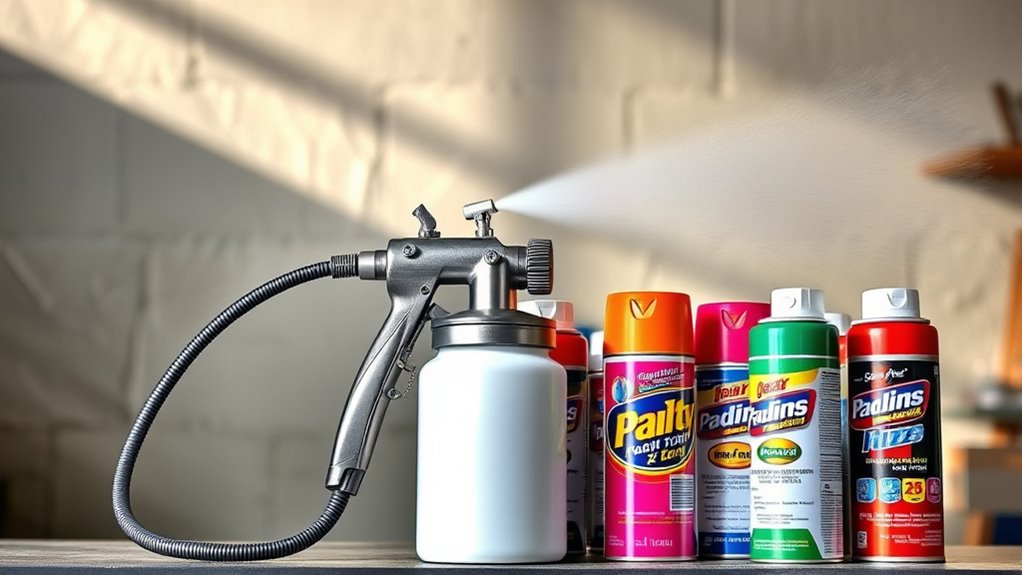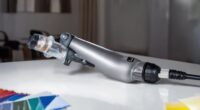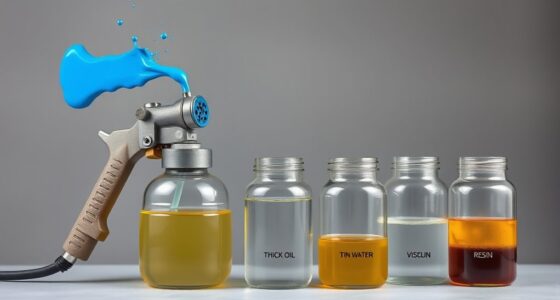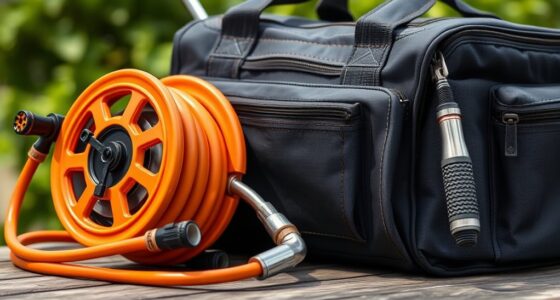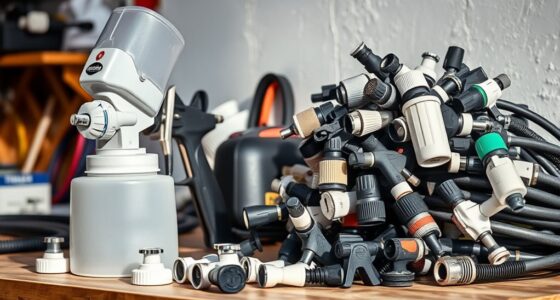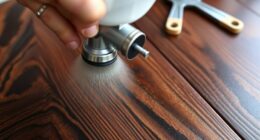Choose a spray gun for larger projects, detailed work, or when you need a professional finish. They handle thicker paints and offer better control for precision tasks, making them ideal for furniture or automotive jobs. Spray cans are best for quick touch-ups, small crafts, or portable use where speed matters. Understanding your project size and finish goals helps determine the right tool. Keep exploring to discover tips for making the best choice for your needs.
Key Takeaways
- Use spray guns for large projects requiring durable, even coverage and precise control over paint flow and patterns.
- Opt for spray cans for quick, small-scale tasks like touch-ups, crafts, or detailed work with minimal setup.
- Choose spray guns for projects involving thicker paints or coatings needing professional, long-lasting finishes.
- Select spray cans when portability and speed are priorities, especially for small areas or on-the-go applications.
- Consider long-term investment and project size: spray guns are more cost-effective for frequent, extensive use.
Differences in Design and Operation
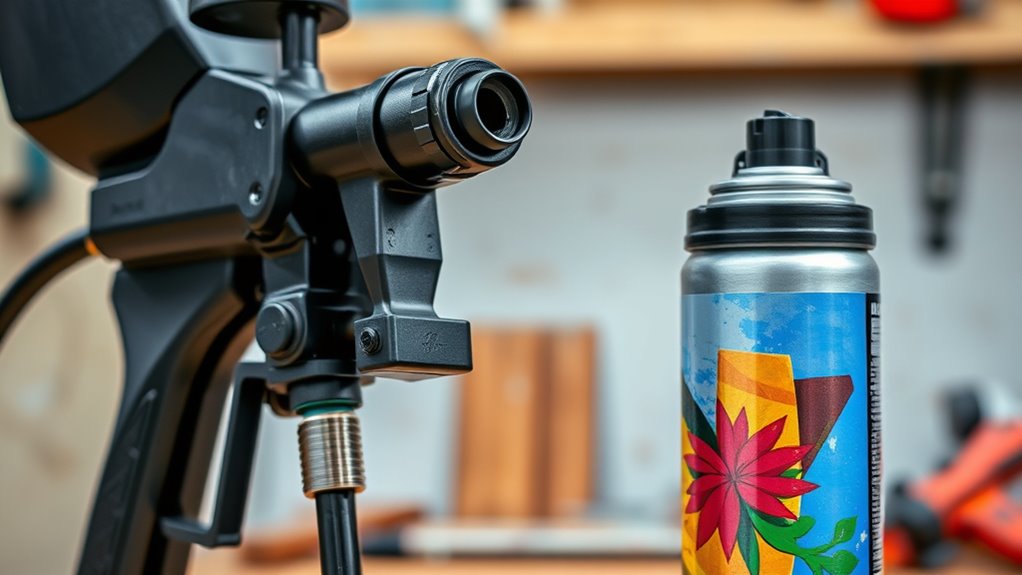
Spray guns and spray cans differ considerably in their design and how they operate. With spray guns, you control the airflow mechanism, which determines how much paint is released and how finely it’s atomized. The nozzle design in spray guns is adjustable, allowing you to customize the spray pattern and coverage, making them ideal for detailed work. airflow control in spray guns plays a crucial role in achieving professional-quality finishes. Additionally, proper technique is essential for optimal results with spray guns, requiring practice to master even spray distribution. Spray cans, on the other hand, rely on a pressurized container that forces paint through a fixed nozzle when you press the valve. The airflow is generated by the propellant, which creates a consistent, atomized spray. While spray guns offer more control and versatility, spray cans provide convenience and portability. Understanding these design differences helps you choose the right tool for your project’s specific needs.
Ideal Projects for Spray Guns
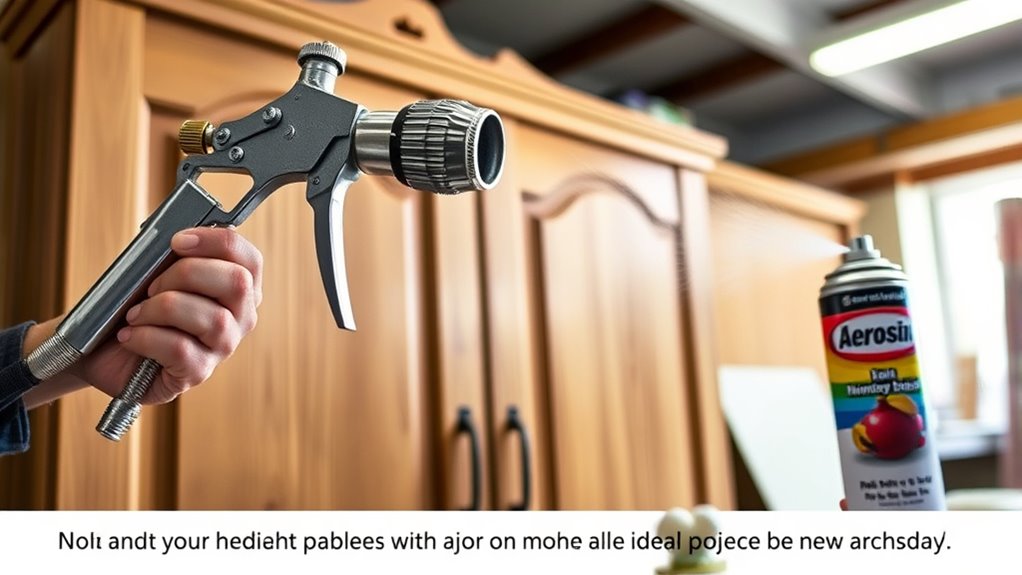
Because spray guns offer precise control over spray patterns and atomization, they excel in projects that demand a high level of detail and a professional finish. They’re ideal for automotive painting, furniture refinishing, or large-scale home projects where durability is key. A spray gun’s durability ensures it can withstand frequent use and tough materials without losing performance. Unlike aerosol cans, which prioritize portability, spray guns are better suited for extensive jobs where consistent coverage and fine control are necessary. They handle thicker paints and coatings more effectively, resulting in a smoother, more durable finish. Proper equipment maintenance is essential to keep your spray gun functioning optimally over time. If your project requires precision, quality, and long-lasting results, a spray gun is the perfect tool to achieve those goals efficiently.
Best Uses for Aerosol Cans

Aerosol cans are best suited for quick, portable projects where convenience and ease of use matter most. Their aerosol convenience allows you to paint or touch up surfaces without setting up bulky equipment. They’re ideal for small-scale or on-the-go tasks that require minimal prep time. You can easily carry them to various locations, making them perfect for portable applications. Use aerosol cans for:
Aerosol cans are perfect for quick, portable projects needing fast, easy application.
- Touching up minor scratches or chips on furniture or vehicles
- Painting small decorative items or crafts
- Applying spray adhesives or protective coatings quickly and efficiently
- They are also useful for quick repairs, enabling rapid application without the need for extensive setup or equipment.
- For larger projects or those requiring precise control, electric paint sprayers or manual spray guns may be more appropriate. Additionally, aerosol cans are suitable for targeted applications, where precision and minimal overspray are desired.
Precision and Control in Painting Tasks
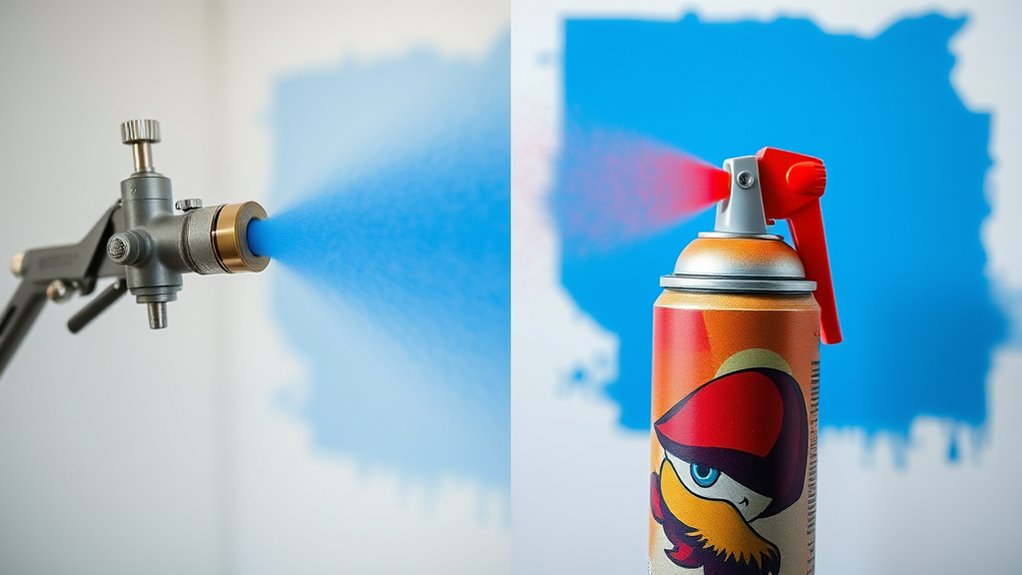
When you need fine detail work, a spray gun offers better control than a spray can. You’ll need a steady hand to maintain precision and avoid overspray. Consistent spray patterns are essential for achieving professional-looking results with both tools. Additionally, understanding security measures in payment processing can help protect your investment in painting equipment against cyber threats. Implementing proper storage solutions for your tools and materials can also prevent accidents and prolong their lifespan, ensuring your workspace remains safe and organized. For those working on larger projects, a best anime movies can be a useful resource for inspiration and relaxation during breaks. Moreover, mastering inspirational quotes about fatherhood can motivate you to approach your painting tasks with dedication and pride.
Fine Detail Application
While both spray guns and spray cans can achieve fine detail, spray guns generally offer greater precision and control for intricate painting tasks. With a spray gun, you can adjust spray patterns and flow rates, allowing for cleaner lines and detailed work. Proper spray gun maintenance ensures consistent performance and prevents clogs, which is vital for fine detail. Additionally, aerosol can storage is straightforward but limits control over spray intensity and pattern. When working on delicate projects, a spray gun’s adjustable nozzle helps you navigate tight spots and small surfaces more accurately. Using proper technique and maintaining your equipment properly can significantly improve your results. Moreover, understanding market factors such as the availability of different spray equipment can help you choose the most suitable tool for your specific needs. Whether you’re doing touch-ups or detailed artwork, choosing the right tool and maintaining it properly makes all the difference. For example, selecting a spray gun with advanced features can reduce repetitive strain during detailed work, enhancing both comfort and precision. Additionally, the variety of paint types compatible with spray guns allows for more tailored finishes suited to different surfaces and projects.
Steady Hand Needed
Achieving precise results with spray guns or spray cans requires a steady hand, as even slight movements can lead to uneven lines or overspray. Your control over brush techniques is vital, especially when aiming for clean edges and smooth finishes. Proper paint mixing ensures the right consistency, making application easier and reducing the tendency to drift or sputter. When using a spray gun, maintaining a steady hand helps you keep a consistent distance from the surface, preventing uneven coverage. With spray cans, a stable grip minimizes accidental runs or missed spots. Practicing your hand stability and mastering paint mixing can greatly improve your results, allowing for more accurate, professional-looking paint jobs regardless of the tool you choose. Incorporating crochet techniques can also help develop fine motor skills and steady hand control, which are valuable for detailed painting work.
Consistent Spray Pattern
Maintaining a consistent spray pattern is essential for achieving smooth, professional finishes. When your spray pattern stays uniform, you ensure application uniformity, reducing streaks or uneven coverage. To improve spray pattern consistency, focus on:
- Keeping a steady distance from the surface to prevent irregularities
- Moving your hand at a consistent speed to avoid thick or thin spots
- Regularly cleaning your equipment to prevent clogging that disrupts spray flow
These practices give you better control over the spray, helping you apply paint evenly across surfaces. Whether using a spray gun or aerosol, mastering consistency enhances the overall quality of your work and minimizes rework. Precision in your technique leads to a flawless, professional look every time.
Surface Area and Size Considerations
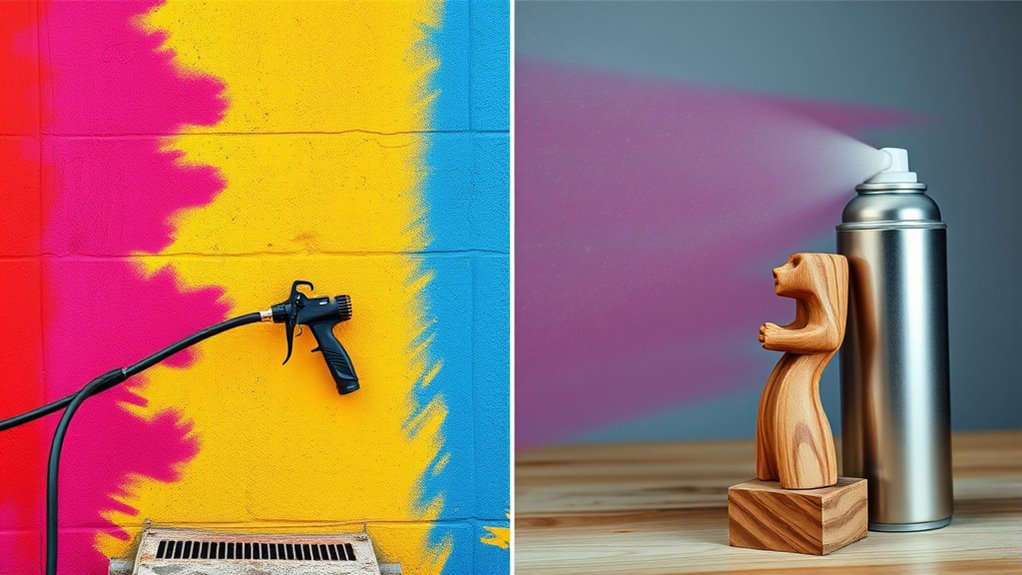
When choosing between a spray gun and a spray can, considering the surface area you need to cover is essential. Larger projects require more efficient surface coverage, making a spray gun often the better choice. Spray guns are designed for extensive areas, providing consistent coverage without frequent reapplication. They save you time and effort on big projects like walls, fences, or furniture. Conversely, spray cans are suitable for small, detailed jobs or touch-ups, where precision and control matter most. The project scale determines your equipment choice—spray guns excel for big surfaces, while spray cans work best for quick, small-scale tasks. By matching your equipment to the size of your project, you guarantee efficient, even coverage every time. Additionally, considering the application method can help you choose the right tool for optimal results. Proper storage and maintenance of your equipment will ensure it performs well over time, especially during large projects. Being aware of equipment performance metrics like spray pattern consistency and atomization can further enhance your results. Moreover, understanding project complexity can guide you toward the most suitable equipment for achieving professional-looking finishes.
Budget and Cost-Effectiveness

When comparing spray guns and spray cans, you’ll want to contemplate both the initial costs and ongoing expenses. Spray guns often require a higher upfront investment but can save you money over time with refills. Conversely, spray cans are cheaper initially but may become more expensive if you need large quantities regularly. Additionally, considering the cost-effectiveness of different options can help determine which method best suits your project and budget. Incorporating Design Thinking principles, such as empathy for your project needs and iterative assessment of costs, can lead to a more informed decision that balances efficiency and affordability. Understanding the long-term value of investing in a quality paint sprayer can also influence your choice, especially for frequent or large-scale projects. Evaluating hydrocolloid technology and other advancements in spray equipment may improve your results and overall satisfaction with the investment.
Initial Investment Analysis
Evaluating the initial investment for spray guns versus spray cans reveals significant differences in upfront costs and long-term value. Spray guns typically require a higher initial cost but can be more cost-effective over time. When considering a cost comparison, you should factor in maintenance expenses, which vary between the two options. Proper filtration and pump protection for spray guns can help maintain performance and reduce long-term costs by preventing clogs and damage. Additionally, understanding the performance differences between the two can influence your overall investment efficiency. For instance, regional popularity of spray equipment can affect availability and support, impacting maintenance and operational costs. Ultimately, your choice depends on how often you’ll use the equipment and whether long-term savings justify the upfront expense.
Long-term Expense Comparison
Over the long term, spray guns often prove more cost-effective than spray cans, especially if you plan to use them frequently. While the initial investment is higher, spray guns reduce ongoing expenses by requiring fewer paint replacements. You’ll also save on paint storage, as spray guns use larger quantities more efficiently, minimizing waste. Maintenance costs are generally manageable with regular cleaning and occasional repairs, which are often cheaper than buying numerous spray cans. Additionally, a spray gun’s durability means it can last for years with proper care, spreading out your expenses over time. If you’re a frequent painter, investing in a spray gun can lower your overall expenses and streamline your projects, making it a smarter choice for budget-conscious users.
Ease of Use and Setup Time
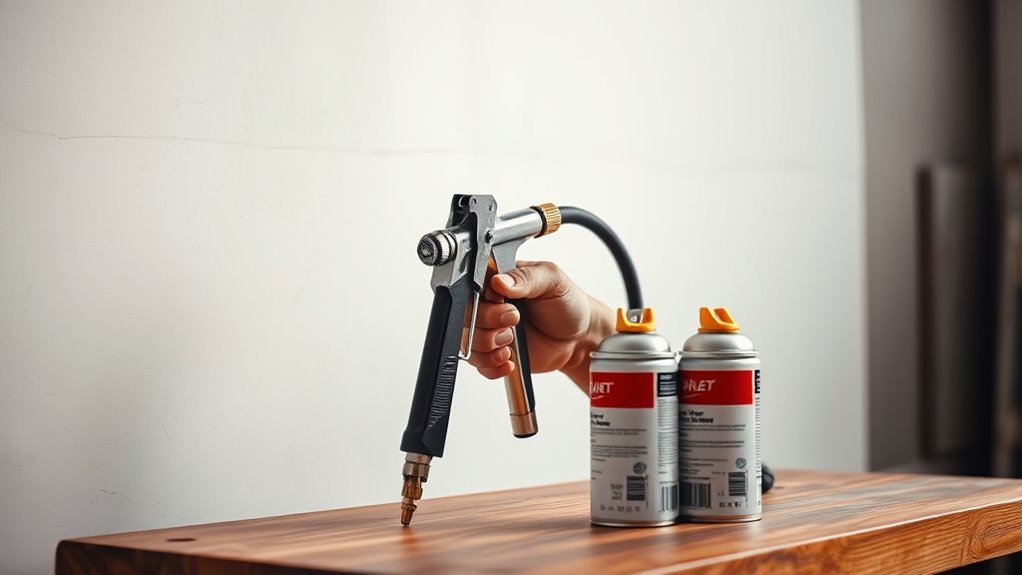
Have you ever wondered which option is easier to get started with—spray guns or spray cans? Spray cans offer quick setup and portable convenience, making them ideal for small projects or quick touch-ups. You simply shake, spray, and go. Spray guns, on the other hand, require more effort upfront, involving assembly, cleaning, and adjusting settings, which can be time-consuming.
Consider these factors:
- Spray cans are ready to use almost immediately, perfect for fast jobs.
- Spray guns need initial setup, but provide more control for larger projects.
- Both tools require some cleaning afterward, but spray guns demand more maintenance.
Choosing the right tool depends on your project size and need for convenience versus precision.
Types of Paint and Finish Quality
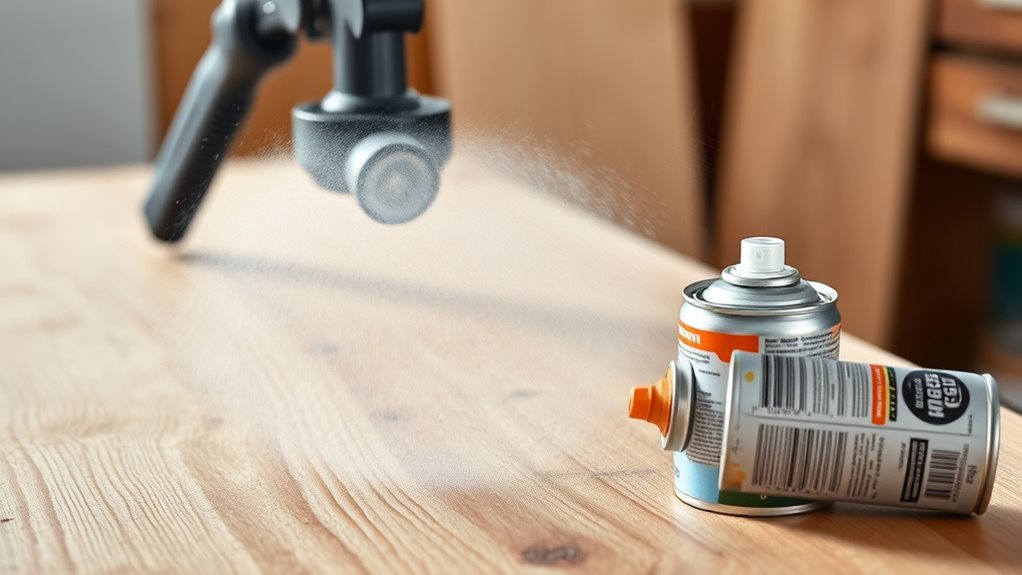
The type of paint you choose considerably impacts the finish quality you’ll achieve with spray guns or spray cans. Different paints offer various textures and gloss levels, influencing your overall look. Spray guns often handle thicker paints, providing smoother, more even coats, but achieving a high-quality finish may require proper brush techniques during touch-ups. Spray cans are ideal for smaller projects and quick jobs, though they might produce less uniform results. Drying times also vary; fast-drying paints can speed up your project but might demand careful application to avoid imperfections. For a flawless finish, consider how the paint’s consistency and drying characteristics align with your method. Selecting the right paint type ensures your project looks professional and lasts longer.
Safety and Environmental Factors
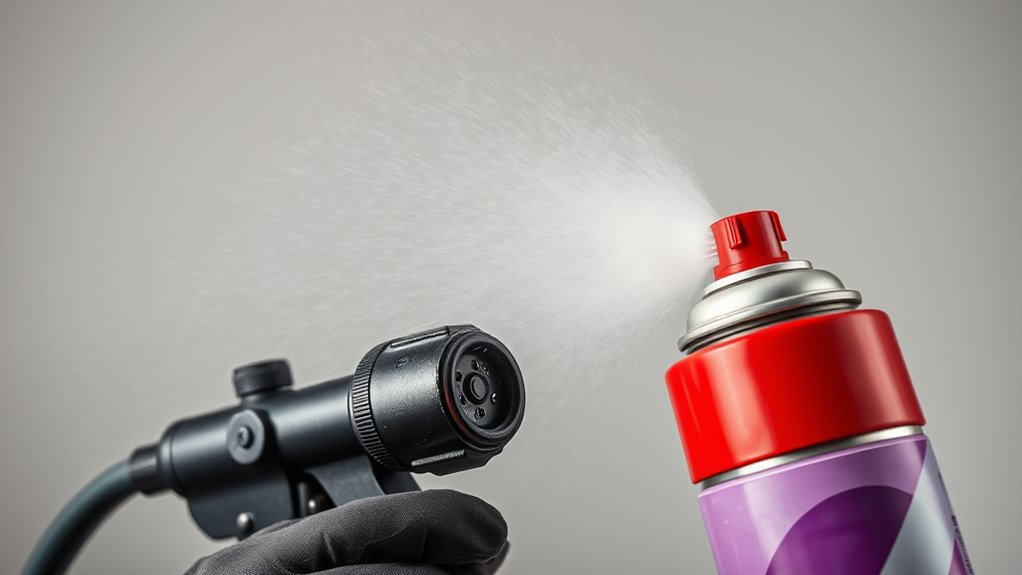
Choosing the right spray method also involves considering safety and environmental impacts. With spray guns and cans, you face different risks related to chemical exposure and waste. Spray guns typically emit fewer volatile organic compounds (VOCs), reducing health hazards, but you must guarantee proper ventilation. Spray cans often contain propellants that can contribute to air pollution and pose inhalation risks. To minimize environmental impact, look for recyclable options and proper disposal methods. Be mindful of these factors:
- Use protective gear to avoid chemical exposure during application
- Opt for spray products with eco-friendly, recyclable packaging
- Follow disposal guidelines to prevent pollution and waste buildup
Prioritizing safety and eco-conscious choices helps protect your health and the environment.
Frequently Asked Questions
Can Spray Guns Be Used for Detailed or Intricate Painting Jobs?
Yes, spray guns can be used for detailed or intricate painting jobs. With the right techniques, you can achieve precision detailing and handle intricate artwork effectively. Choose smaller nozzle sizes and adjust pressure settings to regulate the spray. This allows you to work on fine lines and complex designs, making spray guns versatile for both large projects and delicate, detailed work. Practice helps guarantee your results are clean and professional.
How Do Weather Conditions Affect Aerosol Can and Spray Gun Performance?
Weather conditions are like a puppeteer pulling strings on your project. Humidity impact can cause paint to bubble or run, while high temperatures might make aerosols burst prematurely or dry too quickly. With a spray gun, temperature considerations affect paint flow and curing time. To get a perfect finish, always check the forecast, work in controlled environments, and adapt your techniques to weather, so your masterpiece isn’t left in the storm.
Are There Specific Paints Incompatible With Spray Guns or Aerosol Cans?
You should be aware that certain paints may have paint compatibility issues with spray guns or aerosol cans. Some coatings, especially thick or solvent-based paints, might clog or damage spray equipment, leading to coating restrictions. Always check the manufacturer’s guidelines for paint compatibility, and choose the right application method to avoid issues. Properly selecting compatible paints guarantees a smooth finish and prevents equipment damage.
What Maintenance Is Required for Spray Guns Compared to Aerosol Cans?
Did you know spray guns can last up to 10 years with proper maintenance? You need to regularly clean the nozzle, filters, and paint passages after each use to prevent clogs, following specific cleaning procedures. For storage, keep spray guns disassembled, dry, and in a safe place. Aerosol cans require minimal maintenance—just make sure they’re stored upright and away from heat. Proper care extends their usability and ensures safe, effective application.
How Do Drying Times Differ Between Spray Gun and Aerosol Applications?
When comparing drying times, spray guns typically offer a faster drying speed due to their controlled application and atomization, allowing paint to set quickly. Aerosol cans, however, often have a longer curing time because of the thinner layers and quicker evaporation. You’ll notice that spray guns generally produce a more durable finish with quicker overall drying, whereas aerosols are more convenient for quick jobs but may require more time to fully cure.
Conclusion
Choosing between a spray gun and an aerosol can is like selecting a brush or a pen—you decide how much control and detail you desire. Each tool embodies a different form of expression, shaping your project’s story. Your choice reflects your vision, patience, and purpose. Remember, the right tool doesn’t just paint a surface; it weaves your intention into every stroke, turning mere materials into a lasting masterpiece.
A seasoned painter with over 15 years in the industry, Mike transitioned from hands-on painting projects to the digital world of paint sprayers. His extensive experience gives him a unique perspective on what users truly need when it comes to painting tools. As the Editor in Chief of Paint Sprayer Zone, Mike ensures that every piece of content not only provides value but also reflects the realities of painting — the challenges, the joys, and the intricate details.
